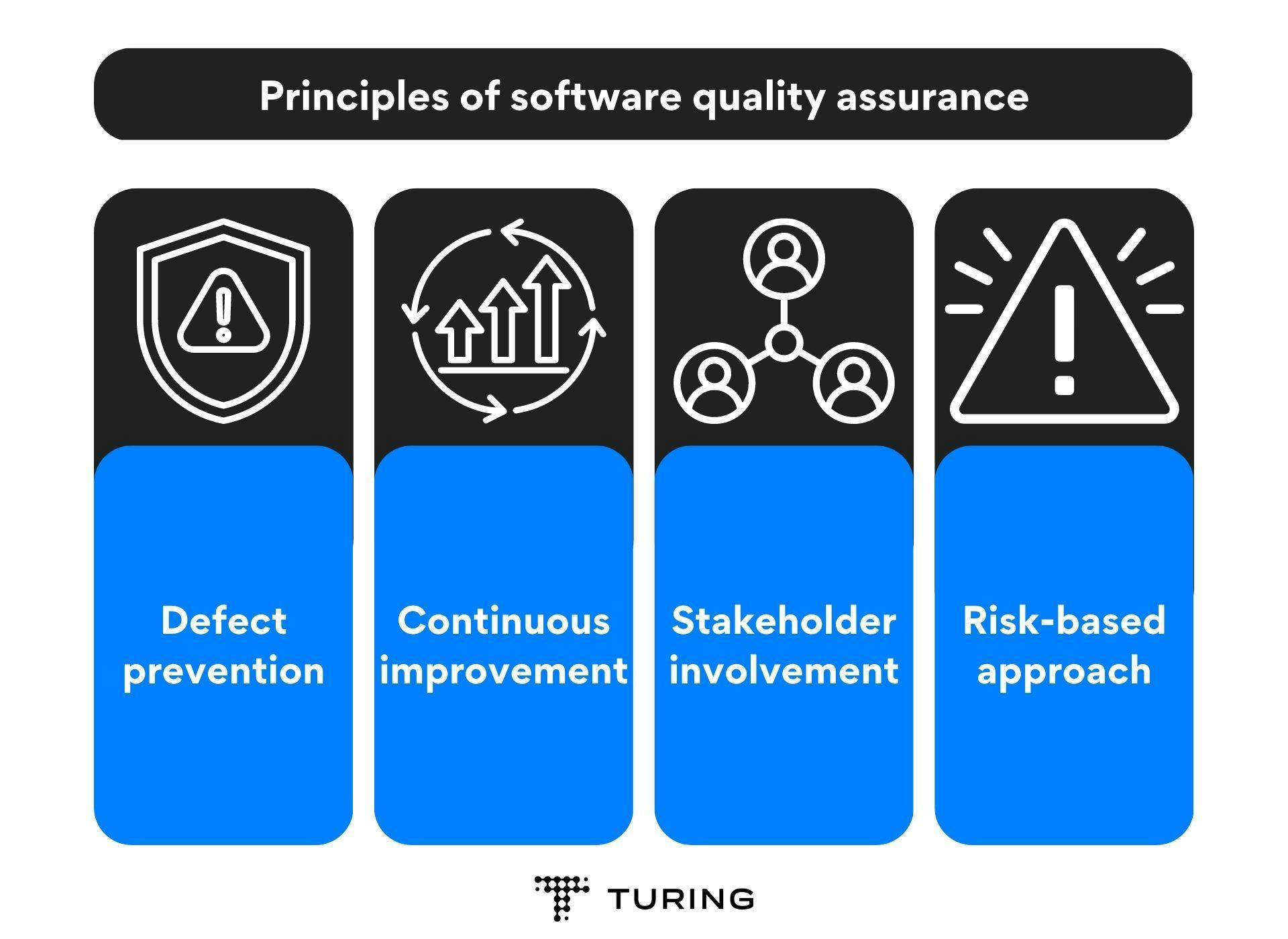Software quality assurance plays a vital role in the software development life cycle. Enterprises are constantly churning out software applications left, right, and center to keep up with the increasing demand. While releasing software applications is one thing, it’s crucial to ensure that the product works the way you want it to.
People are not just looking for a wide selection of software choices; they also want quality products. In this post, we’ll understand what is software quality assurance, its principles, ways to implement SQA, the different SQA approaches, the importance of SQA, and how it differs from software testing and quality control. So, let’s dive in!
What is software quality assurance?
Software quality assurance (SQA) is a methodology to ensure that the quality of the software product complies with a predetermined set of standards.
What is the purpose of software quality assurance? SQA is not just a step in the development process; it functions in parallel with the software development life cycle. Businesses must ascertain that every part of the software, internal and external, is up to the predefined standard. SQA tests every block of this process individually to identify issues before they become major problems.
- Externally, businesses evaluate efficiency, reliability, and cost of maintenance.
- Internal characteristics tested by software QA processes include structure, complexity, readability, flexibility, testability, and the coding practices developers have followed to develop the software.
What are the principles of software quality assurance?

Principles of Software Quality Assurance
Now that we’ve covered the basics of software quality assurance, let’s look at the principles. If you want to implement software quality assurance effectively, you must follow certain principles. These principles not only ensure that SQA is conducted efficiently but also see to it that your software product meets the best quality standards.
Let’s look at the key principles one by one.
- Defect prevention: It is always better to prevent defects and errors in the software product than to correct them later. And so, the first principle of SQA emphasizes the importance of identifying and addressing potential issues early in the software development lifecycle. Unlike quality control, SQA focuses on fixing the root cause of defects and errors, and not just the symptoms.
- Continuous improvement: Here’s the thing: SQA is not a one-time thing. It is more like an ongoing process you need to integrate into your software development lifecycle. In other words, the second principle, i.e., continuous improvement underlines the need to consistently monitor and improve the quality of the software product.
- Stakeholder involvement: SQA must involve all stakeholders in the software development process, including customers, developers, testers, QA team leads, and project managers. And thus, this third principle talks about the importance of collaboration and communication between the involved parties to ensure a smooth software development process.
- Risk-based approach: Last but not least, SQA must focus on identifying and addressing the most significant risks in the software product. Simply put, this principle emphasizes the importance of prioritizing risks based on their potential impact on the software product.
How to implement software quality assurance?

How to implement software quality assurance
To implement SQA effectively, it is essential to follow a structured approach. You can follow the below-mentioned steps to implement SQA:
- Define quality standards: Clearly define the quality standards that your software product must meet. This includes defining requirements, acceptance criteria, and performance metrics. These standards should be agreed upon by all stakeholders, including the development team, management, and customers.
- Plan SQA activities: Develop a plan for the SQA activities that will be performed throughout the software development life cycle. This plan should include reviews, testing, and documentation activities. It should also specify who will be responsible for each activity and when it will be performed.
- Conduct reviews: Conduct reviews of software artifacts such as requirements, design documents, and code. These reviews should be conducted by a team of experts who are not directly involved in the development process. This will help identify defects early in the development process and reduce the cost of fixing them later.
- Perform testing: Perform different types of testing such as unit testing, integration testing, system testing, and acceptance testing. Use automated testing tools to increase efficiency and reduce the risk of human error.
- Monitor and measure: Monitor and measure the quality of the software product throughout the development process. This includes tracking defects, analyzing metrics such as code coverage and defect density, and conducting root cause analysis.
- Improve continuously: Continuously improve the SQA process by analyzing the results of the monitoring and measuring activities. Use this data to identify areas for improvement and implement changes to the SQA process.
What are the different software quality assurance approaches?
We have divided this section into parts based on the approaches to software quality assurance.
Part 1: From a broader perspective, there are two different approaches to software QA:
- Software quality defect management approach
The software quality defect management approach focuses on counting and managing defects. The level of severity can generally categorize defects. Software development teams use tools like defect leakage matrices and clear and concise control charts to measure and enhance the capability of their software development process. - Software quality attributes approach
The software quality attributes approach works by helping software engineers analyze the performance of a software product. This approach focuses on directing the engineer’s attention to several quality factors. While some of these attributes may overlap or fall under another, there are five essential quality characteristics that you should consider: - Reliability: Reliability reflects the system’s ability to continue operating overtime under different working environments and conditions. The application should consistently return correct results.
- Usability: Software applications should be easy to learn and navigate. This user-friendliness and effectiveness of utilizing the product are called usability.
- Efficiency: This software QA attribute indicates how well the system uses all the available resources. It is shown by the amount of time the system needs to finish any task.
- Maintainability: It shows how easy it is to maintain different system versions and support changes and upgrades cost-effectively.
- Portability: This software quality assurance attribute demonstrates the system’s ability to run effectively on various platforms — for example, data portability, viewing, hosting, and more.
Part 2: In addition to the ones mentioned above, there are different approaches to SQA that organizations can use based on the type of their software development process.
- Traditional approach: The traditional approach, also known as the Waterfall mode, includes a sequential process where each phase of the software development lifecycle is completed before moving on to the next phase. Similarly, SQA is performed at the end of each phase to ensure that the requirements have been met before moving to the next phase. This approach involves requirement analysis, design, coding, testing, and maintenance to ensure that the software product is developed with minimal errors and defects and meets the desired quality standards.
- Agile approach: The Agile approach to SQA is an iterative, incremental, and flexible approach that focuses on delivering software products in small increments. This approach emphasizes collaboration between the development team and the stakeholders for a seamless and quick development process. Agile SQA is quite popular and focuses on self-organizing teams, continuous integration and testing, continuous delivery, and continuous feedback to ensure a high-quality software product.
- DevOps approach: Next is the DevOps approach. This is basically a combination of development and IT operations to ensure that the software product meets the requirements of the customers. This approach emphasizes collaboration, automation, and continuous delivery to deliver the software product quickly and efficiently. Just like Agile, DevOps best practices comprise continuous integration, continuous testing, and continuous deployment to deliver a high-quality product. This approach is great for projects that require frequent updates.
- Six Sigma approach: This is a data-driven approach that focuses on reducing defects and errors in the software product. The approach uses statistical tools and techniques to measure and improve the quality of the software product. It is suitable for projects that prioritize reducing defects and errors.
- Lean approach: This is an approach that focuses on efficiency and waste reduction in the software development process. It emphasizes continuous improvement and the elimination of non-value-added activities. It is suitable for projects that require a focus on efficiency and waste reduction.
- Continuous integration and continuous deployment (CI/CD) approach: This is an approach that focuses on continuous integration and deployment of software products. The CI/CD approach emphasizes automation, continuous testing, and continuous delivery of software products. It is suitable for projects that require continuous integration and deployment.
- Test-driven development (TDD) approach: This approach involves writing automated tests before writing the code to ensure that the code meets the requirements and specifications of the software product. TDD SQA involves various activities, such as writing unit tests, running the tests, and refactoring the code, to ensure that the software product is of high quality.
- Risk-based approach: Last but not least, the risk-based approach to SQA involves identifying and managing the risks associated with the software product. This approach is made up of risk assessment, risk mitigation, and risk monitoring to ensure that the software product meets the established standards.
In conclusion, there are different approaches to software quality assurance that organizations can use to ensure that their software products meet the highest quality standards. The choice of approach depends on the organization’s goals, requirements, and resources.
What is the importance of software quality assurance?

Why is Software Quality Assurance important?
The importance of SQA in software engineering can be divided into the following:
- Ensures a high-quality software product: Software quality assurance ensures that the software meets the specified quality standards and requirements. This results in software that is more reliable, efficient, and user-friendly.
- Saves time and money: SQA ensures that the developers find bugs and errors at the early stages of software development. Therefore, they spend a lot less time and money fixing them.
- Builds a stable and competitive software product: Software architects specifically vet each block in the software development process against industry standards. Granular testing for different requirements like reliability, functionality, usability, portability, etc., helps ensure that their product is high-quality.
- Protects your company’s reputation: Businesses need to ensure that their product works as intended before releasing it into the market. If the customers notice the product’s errors before you do, it will significantly impact your brand image and reputation.
- Ensures security and compliance: Software quality assurance helps organizations ensure that their application is efficient, secure, and trustworthy. Most importantly, it helps them meet regulatory and industry-specific compliance requirements, such as those related to security and data privacy.
- Ensures customer satisfaction: Your software application has to fulfill all the needs to satisfy the customers. It has to work smoothly without any malfunctions. With software quality assurance processes in place, you can ensure that your product delivers everything that your audience expects.
Thus, the importance of software quality assurance cannot be underestimated. Conducting a thorough SQA is a vital step for launching a successful software product.
What is the difference between quality assurance and quality control?
Quality control and quality assurance are two important concepts in software development that are often confused with each other. Both these concepts are related to the quality of software products but differ in their approach and objectives.
Below, we have listed the key differences between quality assurance and quality control in software development.

Difference between quality assurance and quality control
Final thoughts
The role of software quality assurance in software engineering is to ensure that software products and systems are developed and maintained to meet the required quality standards and functional requirements. SQA is a critical component of the software development life cycle (SDLC) that involves continuous monitoring and improvement of software development processes to identify and eliminate defects and errors in the software product. SQA is a great way for businesses to ensure that they have tested every part of their product to the highest standards before releasing it into the market.
If you’re a business looking to launch a great software product, you cannot possibly undermine the importance of SQA.
But before you start with software quality assurance, you need to hire developers who can help you build a product in the first place. With Turing, you can hire pre-vetted, highly skilled, and experienced software developers at excellent prices. The best part? You get a 14-day no-risk trial. If you decide to stop within two weeks, you pay nothing.
FAQs
- What is software quality?
Software quality is the study and practice that highlights the desirable and favorable attributes of a given software product. The two primary approaches to software quality are 1. defect management and 2. quality attributes. - What are the three definitions of software quality?
The three primary aspects of software quality are functional quality, structural quality, and process quality. - What are the main software quality characteristics?
Six of the most important quality characteristics are maintainability, correctness, reusability, reliability, portability, and efficiency.
Jayalakshmi Iyer
Sanika
Want to accelerate your business with AI?
Talk to one of our solutions architects and start innovating with AI-powered talent.



